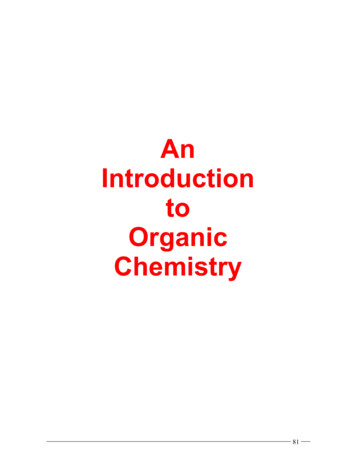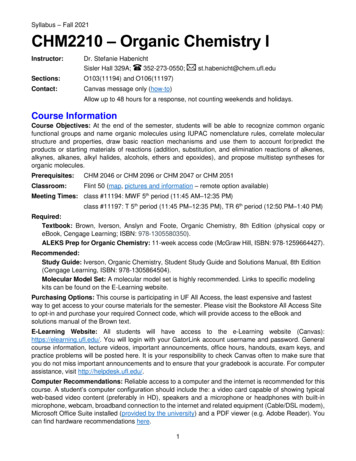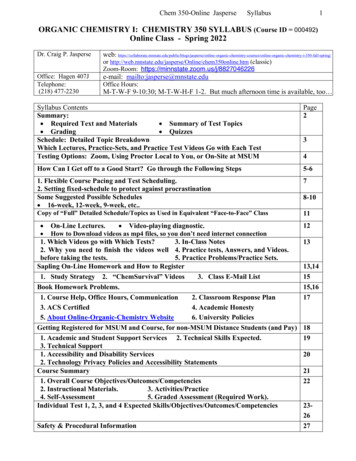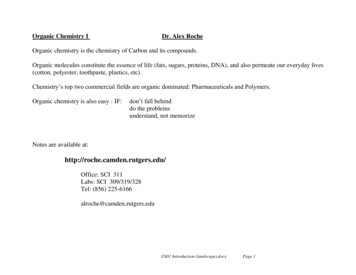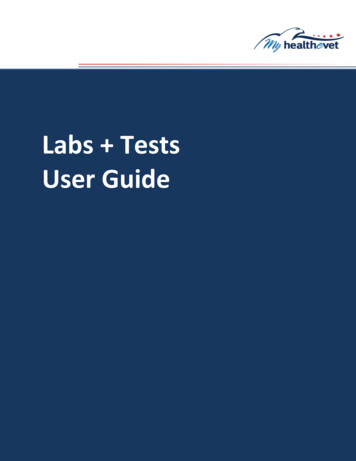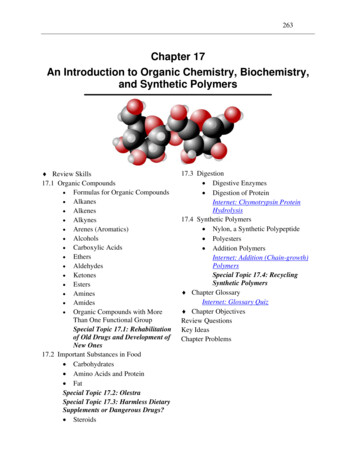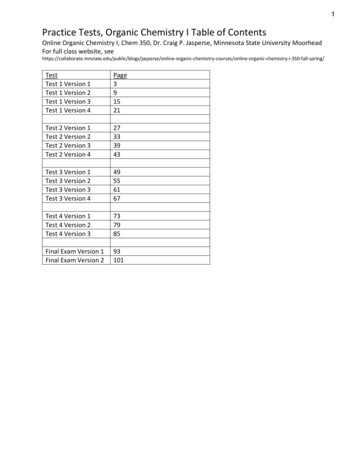
Transcription
1Practice Tests, Organic Chemistry I Table of ContentsOnline Organic Chemistry I, Chem 350, Dr. Craig P. Jasperse, Minnesota State University MoorheadFor full class website, anic-chemistry-i-350-fall-spring/TestTest 1 Version 1Test 1 Version 2Test 1 Version 3Test 1 Version 4Page391521Test 2 Version 1Test 2 Version 2Test 2 Version 3Test 2 Version 427333943Test 3 Version 1Test 3 Version 2Test 3 Version 3Test 3 Version 449556167Test 4 Version 1Test 4 Version 2Test 4 Version 3737985Final Exam Version 1Final Exam Version 293101
2
31JASPERSECHEM 350 TEST 1VERSION 1 Organic Chemistry I - JasperseIntro and ReviewStructure and Properties of Organic MoleculesStructure, Nomenclature, and Conformation/Stereochemistry of Alkanes1. Draw the correct Lewis structure of CH3CN. (Needn’t show 3-D geometry) (3pt)2. Draw the correct Lewis structure for HOCH2CHO. (Needn’t show 3-D geometry). (3pt)3. Draw a 3-dimensional picture for the atoms in CH3CO2CH2NHCH3, using the hash-wedgeconvention. (You needn’t specify lone pairs, and orbitals need not be shown). (5pt)4. For the structure shown, what is the hybridization, electron-pair geometry, and approximatebond angle (90, 109, 120, or 180) relative to: (6pt)13 4HO 2O75 6 N 8H9electron-pair bondhybridization geometryangleelectron-pair bondhybridization geometryangleO-1C-5C-2N-7C-3O-95. Assign any formal charges to any apropriate atoms for proline, given the structure shown (oneof the body’s 20 monomers from which protein and enzyme biopolymers are constructred). (3pt)OONH 21
426. Rank the acidity of the following, from 1 (most) to 4 (least). (4pt)OHOHNHO7. Which of the following represent pairs of resonance structures? (4pt)a.b.c.OCH 3OCH 3BrBrd. Both a and ce. a, b, and c are all resonance structures.8. Draw arrows to show electron-movement in the following two steps (draw arrows for eachstep). Draw a circle around the atom that functions as nucleophile in step 1, and a square aroundthe atom that functions as nucleophile in step 2. (5pt)OBrStep 1 OHOBrStep 2OH(anion)O BrOH9. Rank the series on the basis of boiling point, 1 having highest boiling point, 3 having lowest.(3pt)OOH10. Rank the series on the basis of water solubility, 1 having highest solubility, 3 having lowest.(3pt)OHOH2
5311. For each of the following pairs of resonance structures, circle the one that would make agreater contribution to the actual resonance hybrid. (4pt)OOOCH3OCH3(anions)12. Cyclopropane is much more “strained” than cyclopentane. Why? (Short!) (3pt)13. For the following acid-base reaction,a. put a box around the weakest base in the reactionb. put a circle around the weakest acidc. draw an arrow to show whether the equilbrium goes to the right or left. (4pt)OONa H 2OO NaOHOH14. Classify the relationship between the pairs of molecules as either: (8pt)same compoundstructural isomersresonance structuresgeometric isomersnot isomers (different molecular formulas)OHOHHCH3CH3H HHHCH3HBrBrH CH3HH3OHHHHOH
6415. Give the name for the following. (7pt)HHCH316. Identify all the funtional groups in the following molecules. (Do not include “alkane”, sincethat isn’t “functional”.) (6pt)ONOOOOH17. Which of the following pair will have the larger rotation barrier, relative to the bondsindicated? (3pt)18. For the following Newman projections, rank them in stability from 1 to 4, 1 being moststable. Identify the “anti” conformation, the “gauche” conformation, and the “totally eclipsed”conformation. (6pt)HCH3CH3 HH HHHCH3HH3CCHHHCH3H3HHH3CHH3CHHH19. Draw the Newman projection for the most stable conformation of 1,2-dichloroethane. (3pt)4
7520. Draw the two chair conformations of cis-1-ethyl-4-methylcyclohexane. (You don’t have todraw all the hydrogens). (5pt)21. Which is more stable, cis- or trans-1-t-butyl-2-methylcyclohexane?conformation of the more stable isomer. (4pt)Draw the best22. Draw as many structural isomers as you can for C6H14. Be careful not to draw the sameisomer twice! I will take off points for duplicating! (6pt)5
8
91JASPERSECHEM 350 TEST 1VERSION 2 Organic Chemistry I - JasperseIntro and ReviewStructure and Properties of Organic MoleculesStructure, Nomenclature, and Conformation/Stereochemistry of Alkanes1. Draw the correct Lewis structure of CH3CO2CH2COCH3. (Needn’t show 3-D geometry) (3pt)2. Draw a 3-dimensional picture for the atoms in CH3CH2CHCHCH2NHCH2CHO, using the hashwedge convention. (You needn’t specify lone pairs, and orbitals need not be shown). (5pt)3. For the structure shown, what is the hybridization, electron-pair geometry, and approximate bondangle (90, 109, 120, or 180) relative to: (7pt, 2 points off for each error)O13O245NHelectron-pair bondhybridization geometryangle6electron-pair bondhybridization geometryangleC-1C-4O-2N-5C-3C-64. Assign any formal charges to any appropriate atoms for the structure shown below. (4pt)OHOON CH 3CH 3
1025. Rank the acidity of the following, from 1 (most) to 4 (least). (4pt)HOOHNH 2O6. For the following pairs, identify as “isomers” (“I”) or “resonance structures” (“R”). (6pt)OOOHOH7. Draw arrows to show electron-movement in the following reactions. (These are reactions, notresonance.) (5pt)OO Bra.HH BrOHOO HOb.8. Rank the series on the basis of boiling point, 1 having highest boiling point, 3 having lowest. (3pt)NH 2NH 29. Rank the series on the basis of water solubility, 1 having highest solubility, 3 having lowest. (3pt)OHOH
11310. Circle whichever of the following could fit the formula C5H10? (3pt)11. For the following acid-base reaction,a. put a box around the weakest base in the reactionb. put a circle around the weakest acidc. draw an arrow to show whether the equilibrium goes to the right or left. (4pt)OH NHNaONa ONH 2O12. Classify the relationship between each pair of molecules as either: (10 pt)same compoundstructural isomersresonance structuresstereoisomersH 3COiPrHHH 3COHBriPrHCH 3CH 3HHHHCH2CH 3H BrBrHHNBrHHN
4 1214. Give the name for the following. (7pt)HH15.16. Identify and write down the names for each of the functional groups in each of the followingmolecules. (Do not include “alkane”, since that isn’t “functional”.) For each molecule, try to writethe names in order, as they appear from left-to-right in the molecules. (8pt)OOHOOHONH 2ONH17. Circle which of the following pair will have the larger rotation barrier, relative to the bondsindicated? (2pt) Identify which reason explains why: steric strain, torsional strain, or angle strain?18. For the following Newman projections: (6pt total)a. rank them in stability from 1 to 4, 1 being most stableb. identify the “anti”, “gauche”, and the “totally eclipsed” conformations.HHCH 3HHHHHHCH2CH 3H 3CH2CCH 3HHH 3CHHCH2CH 3HHHH 3CH 3CH2CHc. Is the energy difference between the gauche and the anti conformation based on steric strain,torsional strain, or angle strain?d. In the case of ethane (not shown), staggered conformations are better than eclipsedconformations. Is the difference based on steric strain, torsional strain, or angle strain?19. Draw both the most stable and the least stable Newman projections for 1-bromopropane,BrCH2CH2CH3, relative to C1-C2 bond. - (3pt)
13520. Which of the following are correct Lewis structures, including formal charges, for nitric acid,HNO3. (3 pts)OH N OOa.b.c.d.e.21.A onlyB onlyC onlyBoth A and CAll of the aboveAOH O NBOOH O N OC22. Draw the two chair conformations of cis-1-isopropyl-4-methylcyclohexane. (You don’t have todraw all the hydrogens). (5pt) (Use “iPr” as abbreviation).23. Draw the best chair conformation of the more stable isomer. Which is more stable, cis- or trans-1butyl-2-methylcyclohexane? (4pt)24. Draw any 6 of the 9 possible structural isomers for alkanes with formula C7H16. When decidingwhether to draw cyclic or acyclic alkanes, make sure that you fit the formula! Be careful not todraw the same isomer twice! I will take off points for duplicating! (You can try to show off bygetting more than 6, but if you do still be sure you don’t duplicate!) (6pt)
14
1JASPERSECHEM 350 TEST 1VERSION 3 Organic Chemistry I - JasperseIntro and ReviewStructure and Properties of Organic MoleculesStructure, Nomenclature, and Conformation/Stereochemistry of Alkanes1. (12 points) Give the relationship between the following pairs of structures. The possiblerelationships are the following:same compoundstructural isomersresonance structuresstereo isomersnot isomers (different molecular formula)a.HBrBrHH Brb. H C C HBr Hc.BrHBrBr HH HH C C HBr BrBrd.e.f.2.(8 points) Draw line-angle structures and names for 4 of the 5 structural isomers of C6H14.115
2OH 2N23456OH783. (10 Points)a. For the above structure, what is the hybridization and approximate bond angles (109, 120, or180) about:1C-2C-4C-6O-8b. In the above structure, N-1 is actually found to have 120º bond angles. (This may seemunexpected to you at this point, but we’ll learn why later in the course.) What must be thehybridization of the nitrogen?4.(2 Points) Bond rotation around C6-C7 in the above structure has a 7 kcal/mol barrier, whilerotation around the C4-C5 bond has a 70 kcal/mol barrier. Explain very briefly why it is somuch harder to rotate the latter bond?5. (4 points) For each of the pairs listed, circle the one with the higher boiling point.a.CH3Nb.HNOHOH6. (6 points) Write a Lewis structure and assign any non-zero formal charges.a. [CH3NH3] b. CH3CO2Nac. CH3CHO216
37.(5 points) a) Draw the best resonance structure for anion A, and circle the resonancestructure that would make the greater contribution to the resonance hybrid.ONAb. For the two resonance structures shown below, circle the resonance structure that would makethe greater contribution to the resonance hybrid. NHNH22 8.(6 points) Rank the acidity of the following molecules, 1 being most acidic, 4 being leastacidic. Hint: draw the anions!NH3CH3CH2OHCH3CO2HHCl9. (6 points)Draw a line-angle picture for all of the atoms in the moleculeCH3CH2COCHClCH3, including the hydrogens. Use the hash-wedge convention to indicateatoms that are not in the plane of the paper.10. (5 points) Rank the ring strain in the following, from 1(most) to 3 (least). Explain verybriefly the differences in strain.ABC317
411. (6 points) Which of the following are capable of cis-trans stereoisomerism? (Yes/No).a. 3-ethyl-1,1-dimethylcyclopentaneb. 3-pentene (name means a double bond is between carbons 3 and 4)c. 1,3-dimethylcyclohexane12. (9 points) Identify the functional groups in the following molecules. (Do not include"alkane", since that is not "functional". And do not specify "cyclic".)a. H 2NCO 2H("GABA: brain neurotransmitter")OHCH 3HCH 3 Hb.HOHTestosteroneCH 3 OONCH 3Hc.OHCocaineO418
513. (5 points) Give the IUPAC name for the following compounds.Ha.b.HCH 3CH 2CH 2CH 314. (8 points) a. Draw Newman projections for the totally eclipsed, the gauch, and the anticonformations of 2,5-dimethylhexane, relative to the C3-C4 bond. You may abbreviate theisopropyl groups attached to C3 and C4 as "i-Pr" for convenience.b. Explain very briefly why the rotation barrier around the C3-C4 bond of 2,5-dimethylhexane isgreater than the rotation barrier in butane.43 i-Pr43i-Pr15. (8 points) a.) Draw the two chair conformations of cis-3-methyl-1-isopropylcyclohexane.(You don't need to show the H's on carbons other than 1 and 3). For convenience, you mayabbreviate methyl as "Me" and isopropyl as "iPr"b.) Circle the more stable conformation.c) Would trans-3-methyl-1-isopropylcyclohexane be more stable or less stable than the cisisomer?519
20
1JASPERSECHEM 350 TEST 1VERSION 4 Organic Chemistry I - JasperseIntro and ReviewStructure and Properties of Organic MoleculesStructure, Nomenclature, and Conformation/Stereochemistry of Alkanes1. Order the following according to increasing electronegativity, 1 being highest, 4 lowest. (2pts)NFOC2. Write Lewis structures and assign any non-zero formal charges. (3pts each)a. [CH3OH2] b. CH3CO2CH2ONac. CH3CHCHCONH23. For each of the following, a) draw its resonance structure, and for each pair b) circle thestructure that would make the greater contribution to the resonance hybrid. (2 pts each)Oa.Hb.O 4. Draw line-angle structures for 7 of the 9 structural isomers of C7H16. (5 pts)21
25. For the following pairs of structures, identify them as either: Resonance Structures, StructuralIsomers, Stereoisomers, or Same. (2 pts each)OHOa.b.HCH 3HH 3CCH 3HHH 3Cc.d.e.CH3CH2CH2CH2CH3(CH3)2CHCH2CH36. Rank the acidity of the following molecules, 1 being most acidic, 4 being least acidic. (3 pts)CH3NH2O7.CH3OH CH 3HCO2HOCH3CH3 CH4a) Put a box around the weakest base in the above reaction. (1pt)b) Put a circle around the weakest acid in the above reaction. (1pt)c) Draw an arrow to show whether at equilibrium the reaction will go left-to-right or right-toleft. (2pt)22
38. Draw the line-angle structure for the following condensed structural formula: (CH3CH2)2CO(3pt)9.H 2N123456789a. For the above structure, what is the hybridization, electron-pair geometry, and approximatebond angles (109, 120, or 180) about: (6pt)N-1C-3C-5C-8b. Rank the length of the following bonds, 1 being shortest, 3 being longest. (2pt)C2-C3C4-C5C8-C910. For each of the pairs listed, circle the one with the higher boiling point. (4pt)a.OOHb.c.O11. Draw a 3-dimensional picture for all of the atoms (hydrogens included) in the moleculeCH3CHCHCOCH2CH2NHCH3. Your picture should use the hash-wedge convention toillustrate atoms that are not in the plane of the paper, and should reflect approximate bondangles. (5pt)23
412. Draw a 3-D picture of CH2O showing the π bond as well as the four atoms. (3pt)13. For the following set, rank the solubility in water, from 1 (most soluble) to 4 (least soluble).(3pt)OHOHO14. Identify the functional groups in the following molecules. (8pt)a.b.OOOHONHOH15. Give the IUPAC name for the following compounds. (6pt)a.b.CH 3HHCH 324
516. Draw the Newman projections for the best and worst conformations of butane, and give thenames for these conformations. Briefly explain what “strain factors” make the worstconformation worse than the best conformation. (6pt)17. a.) Draw both chair conformations of cis-1-methyl-2-isopropylcyclohexane. Draw thesubstituents and H-atoms attached to carbons 1 and 2. (You don't need to show the H's on theother carbons). (4pt)b.) Circle the more stable conformation. (1pt)18. Draw the best chair conformation for 1,3-diethylcyclohexane, and identify whether it is “cis” or“trans”. (3pt)19. Use the arrow-pushing convention to show the electron-movement mechanisms for the followtwo reactions. (5pt)a.O OCH 3CH 3OH2b.NH 2 OH2NH 225
26
27JASPERSE CHEM 350 TEST 2VERSION 1Ch. 4 The Study of Chemical Reactions; Ch. 5 StereochemistryCh. 6 Alkyl Halides: Nucleophilic Substitution and Elimination1. Predict the major organic product for each of the following. (3 points each)Br2, hvBrCH3SNaINaOCH2CH32. Show an alkyl bromide and some nucleophile that you could use to make the following bySN2. (3 points)OCH2CH 33. For the structure shown,a. Draw the major elimination productformed upon treatment with H2O/heat.DHBrHHCH3b. Draw the major elimination productformed upon treatment with CH3CH2ONa.c. Draw the major substitution productformed upon treatment with CH3CH2ONa.(3 points each)
28(3 points for each multiple choice question)4. Which of the following is true regarding an SN1 reaction?a. It would be faster at 25 than 50 b. It would be faster in ethanol than in pentanec. Keeping the moles of reactants constant but doubling the quantity of solvent woulddecrease the rate by a factor of 4.d. Stereochemical inversion occurs exclusively6. Which of the following statements is true?a. The rate determining step is always the last step in a reaction mechanism.b. The stability/reactivity principle says that the more stable of two chemicals will be morereactivec. The reactivity/selectivity principle says that the more reactive of two chemicals will be lessselective.d. The activation barrier for a reaction is the difference in energy between reactants and finalproducts.7. Which of the following statements is true about the chlorination of methane?a. In each propagation step a radical is producedb. 6.02 x 1023 initiation events are needed to make one mole of chloromethanec. Most chloromethane is made by combination of a methyl radical with a chlorine radicald. The overall chlorination of methane is strongly endothermic.8. Which of the following statements is FALSE?a. Optically active solutions solutions always contain chiral molecules.b. Two diastereomers always have identical melting pointsc. Optically inactive solutions are either racemic or else contain no chiral chemicals at alld. A solution with 60% optical purity would have an 80/20 mix of enantiomers9. When the reactants shown undergo substitution, which of the products A-D will form? (3points)DBrHa.b.c.d.e.HHCH3A onlyB onlyA and BA, B, and CA, B, C, and DH2OheatD?HOHHDHHDHOH DHCH3CH3 HCH3 HCH3 HOHH AOH BH CH D
2910. Rank the reactivity of the structures shown toward the reactant(s) indicated on the left (1being most, etc.) (3 points each)BrNaOCH2 CH3BrIBrBr2/hvOCH3BrNHLiOLiOHBrH2O, heat,BrBrBr11. Carbocations often rearrange, as shown below. Draw in the hydrogens on the two carbonsinvolved in the rearrangement, and show formal arrow-pushing to illustrate the transformation.(3 points) 12. Draw the mechanism for the following reaction, propagation steps only. (4 points)Br2, hvBr
3013. Draw (3R,6R)-6-bromo-3-chloro-2-methyloctane (3 points)14. Name the following: (3 points)HBr(opticallyactive)HCl15. Classify each of the chiral carbons in the following structures as R or S (there may be morethan one in a molecule). (10 points)HOHCH3HH CH3H ClBr H16. a. Classify each pair as diastereomers, enantiomers, or same. (12 points)b. For the first structure of each pair, circle it if it is not chiralc. For the first structure of each pair, write “meso” by it if it is mesoHOHOHHOHHOHHH BrBr H H BrH BrCl BrHFBr FClH17a. a) Draw all the unique stereoisomers of 2,3-dichlorobutane. Cross out any duplicates.b) Identify which is meso. c) Identify a pair that are related as diastereomers. (5 points)
3118. Draw the mechanisms for the following reactions, using formal arrow pushing. Note: insome case hydrogens that are not illustrated will be involved in bond changes. You would dowell to write them in at the beginning. (12 points total, 3/3/6 distribution)Br NaOHBrBrOHNaOHH2OheatOH(identify the slow step)
32
33JASPERSE CHEM 350 TEST 2VERSION 2Ch. 4 The Study of Chemical ReactionsCh. 5 SterochemistryCh. 6 Alkyl Halides: Nucleophilic Substitution and Elimination1. Rank the reactivity of the following molecules toward Br2/hv. (1 most, 4 least) (3 points)CH3-CH32. Rank the reactivity of the following molecules toward ethanol and AgNO3. (1 most, 4 least)(3 points)BrClClBr3. Rank the reactivity of the following molecules toward NaOCH3. (1 most, 4 least) (3 points)BrBrI4. Rank the reactivity of the following toward 1-iodopropane. (1 most, 4 least) (3 points)CH3ONaCH3CO2HCH3CO2Na5. What is the hybridization of a carbocation? (2 points)CH3SNaBr
346. Predict the major organic product (1 major structure is all that is needed in each case) for eachof the following reactions. (Minor products or inorganic side products need not be drawn.)(3 points each)Br CH3CO2Na Br2Br HhvAcetone NaI Solvent7. Draw the structures for intermediate A and final product B. (4 points)Br2, hvANaOCH3B8. Draw the product when the following substance undergoes E2 elimination. ("D" is deuterium,basically just a labelled hydrogen). If the starting material is optically active, will the product byoptically active? (4 points)H 3C BrHCH3 NaOCH3HD
359. Show an alkyl bromide and some nucleophile that you could use to make the following by SN2.(3 points each)OCH3H OCH310. Draw all possible elimination products that could form from the following reactant. Circle theone that forms in greatest yield. (5 points)OBr11. Which of the following would not increase the rate of an E1 reaction? (3 points)a. an increase is temperatureb. an increase in the "activation energy"c. an increase in the concentration of the alkyl halided. an increase in the stability of the carbocation intermediate12. When comparing the reaction of 2-methylpropane with either Cl2/hv or Br2/hv, which of thefollowing statements is true? (3 points)a. bromine is less reactive and more selectiveb. chlorine is less reactive and more selectivec. bromine is more reactive and more selectived. chlorine is more reactive and more selective13. Which of the following statements is true relative to reactions I-III: (3 points)ICH4 Br CH3 and HBrIICH3CH3 Br CH3CH2 HBrIIICH3CH2CH3 Br (CH3)2CH HBra.b.c.d.I has the smallest energy of activation and the highest energy transition stateII has the smallest energy of activation and I has the lowest energy transition stateIII has the largest energy of activation and the highest energy transition stateIII has the smallest energy of activation and the lowest energy transition state
3614. Classify each of the chiral carbons in the following structures as (R) or (S). (10 points)ClHO H H CH3ClHH OHH CH315. a. Classify each pair of molecules as diastereomers, enantiomers, or same. (12 points)b. Circle any molecules that are chiralc. Write "meso" by any structures that are meso.ClHClHHClHClF CH3 H 3C HHOClFClOH ClCl H H ClCl H16. Which of the following statements is true? (3 points)a. All solutions with chiral molecules are optically activeb. All molecules with chiral carbons are chiralc. A solution that has 50% optical purity has a 50/50 mixture of enantiomersd. Two enantiomers always have identical boiling points17. Draw (2R,3S)-2-bromo-3-chlorohexane (3 points)18. Name the following: (3 points)ClClH
3719. a) Draw all unique stereoisomers of 2,4-dibromopentane. Label each with a letter, A, B, etc.Cross out any duplicates. (8 points)b) Identify any that are chiralc) Identify any that are meso20. a) Draw the mechanism for the following reaction. (Draw the propagation steps only.) (4points)b) Is your product chiral, and if so is it optically active? (1 points)H 3CHBr2, hvH 3CBr21. a) Draw the mechanism for the following reaction. (4 points)b) Identify the slow step. (1 point)OCH3BrHOCH3
38
39JASPERSE CHEM 350 TEST 2VERSION 3Ch. 4 The Study of Chemical ReactionsCh. 5 SterochemistryCh. 6 Alkyl Halides: Nucleophilic Substitution and otal/1001. List the following radicals in order of increasing stability (from most stable 1 to least stable 4)2. List the following alkyl halides in order of decreasing reactivity toward SN1/E1 reactions (frommost reactive 1 to least reactive 4).BrBrBrBr3. List the following alkyl halides in order of decreasing reactivity toward SN2 reactions (frommost reactive 1 to least reactive 4).BrBrBrI4. Rank the bond strength of the following (from strongest 1 to weakest 4).H-BrH-ClH-FH-I5a. Put a 1 by the reaction for which H Eact.b. Put a 2 by the reaction for which Eact 0.c. Put a 3 by the reaction for which Eact H .(Eact activation energy)Br-Br Br Br H3C-H Br H3C H-BrH3C CH3 H3C-CH3
406. Predict the major organic product for each of the following reactions. (Minor products orinorganic side products need not be drawn.) Br2hvBr NaOHBr NaOH7. Show the Starting Alkyl Bromide which gave the following products.H2OOH heat8. Show an alkyl bromide and some nucleophile that you could use to make the following. (Idon't care whether you specify a nucleophile just as the anion Z- or as NaZ with a metalcounterion.)OHCN9. Optically active (R)-2-bromobutane can be converted to 2-butanol under either conditions A orconditions B. Describe the stereochemistry of the product solutions for the two differentconditions.OHNaOH(Conditions A)H BrH2O, heatOH(Conditions B)Conditions Aa.b.c.d.Alcohol is Chiral or Achiral?Optically Active or Not?(R), (S), or both?Reaction occured by Inversion,Retention, or Racemization?e. What happens to the rates if you doublethe concentrations of all reactants?Conditions B
4110. Draw the major product for the following reaction. Then draw the mechanism for itsformation. (Draw the propagation steps only.) Is your product chiral? (You may need to addrelevant hydrogens.) Br2hv11. Draw the major product for the following reaction. Then draw the mechanism for itsformation. (You may need to add relevant hydrogens.)H 3CBr NaOH13. Draw the mechanism for the following reaction. (Don't worry about designating stereochem.)H 3CBrH2OH 3COH H-Br
4214. Classify each of the chiral carbons in the following structures as (R) or (S).HCH3HCH3HO H15. Draw (R)-2-bromopentane16. Draw meso-1,3-dichlorocyclopentane, and mark the chiral C's as (R) or (S).17. Draw all of the different isomers of 2,3-dichlorobutane, identify each as either chiral or meso,and classify the relationship between each two as enantiotopic or diastereotopic. (You may useFischer projections or zig/zag/hash/wedge pictures, as you please. (If two are the same, cross oneof them off your list.)18. Classify the pairs of molecules as diastereomers, enantiomers, or same. For the first moleculein each pair, circle it if it is chiral. For the second molecule in each pair, put a * next to each chiralC.BrHHHOHOHBrHH ClH CH3H 3CH 3C HH 3CCl H
431JASPERSE CHEM 350 TEST 2VERSION 4Ch. 4 The Study of Chemical ReactionsCh. 5 Alkyl Halides: Nucleophilic Substitution and EliminationCh. 6 Stereochemistry1. Draw the mechanism for the following reaction, and write “slow” next to the ratedetermining step. Be sure to draw all intermediates, and to correctly draw “electronmovement” arrows or half-arrows. (Show the propagation steps only.) (4 points)H Hhv Br 2H Br H-Br2. Draw the mechanism for the following reaction, and write “slow” above the ratedetermning step. Be sure to draw all intermediates, and to correctly draw “electronmovement” arrows. (5 points)BrH (catalyst) HOCH3OCH3 H-BrCH3 OH (solvent)heat3. Predict the major products for the following reactions. (4 points each)a)b)Br NaOCH3 Br 2CH3 OH (solvent)hv
442Br NaOCH 3c) Br 2CH3 OH (solvent)hvd)Br CH SNa3e)4. Draw the substitution products for the following reactions. (Do not draw theaccompnaying elimination products). Include stereochemistry in your answer, and iftwo substitution products are formed draw them both. (4 points each)a)HH 3CCl NaOHH2OHcat. HClHHb) 3CClCH3 H2OH2O5. Draw the E2 elimination product(s) [do not draw the substitution product(s)]. (4points each)HCH3BrNaOCH3CH3 OHH6. Of the following alkyl halides, (3 points)a) Circle the one that would be the most reactive toward SN2 substitutionb) Put a box around the one that would be the least reactive toward SN2 substitutionIIClBrCl
4537. Of the following alkyl halides, (3 points)c) Circle the one that would be the most reactive toward SN1 substitutiond) Put a box around the one that would be the least reactive toward SN1 substitutionIClIClBr8. Rank the stability of the following carbocations, from 1 (most stable) to 4 (leaststable) (4 pts) 9. Rank the stability of the following radicals, from 1 (most stable) to 4 (least stable) (4pts) 10. Classify as R or S (2 pts each)H Bra) ClCH3Br Hb)c)d)H 3C HH CH3
46411. Provide the structure and the IUPAC name for the following (3 pts each)a) (R)-3-chloro-2-methylheptaneHb)BrCH312. Classify the paris of molecules as not isomers, structural isomers, diastereomers,enantiomers, or identical, and circle any molecules that are achiral. (2 pts each)HBra)b)HHClHBrBr HH Clc) H 3CBrHBrBrClHH BrH CH3ClBr13. For 1,2-dimethylcyclopentane,a) How many stereocenters are present(8 pts)b) Draw all the possible stereoisomers, and circle those that are chiral.
475Each of the following multiple choice problems is worth 3 points.14. For the reaction shown below, with bond dissociation energies listed below each keybond, the overall H is: H (kcal/mol)a)b)c)d)e)(CH3) 3C-H Cl-Cl (CH3) 3C-Cl H-Cl915878103 58 kcal/mol-32 kcal/mol 32 kcal/mol-57 kcal/mol 181 kcal/mol15. Which factor would not increase the rate of an E1 reaction:a)b)c)d)Use of a more polar solventUse of a 3 rather than a 2 alkyl halideDoubling the concentration of the baseUsing iodide rather than bromide as leaving group16. Consider the SN2 reaction shown below. Assuming no other changes, what effect onthe rate would simultaneously doubling the concentrations of both 1-bromobutaneand KOH have?CH3CH2CH2CH2Br KOH CH3CH2CH2CH2OH KBra) No effectb) It would double the ratec) It would triple the rated) It would increase the rate by four timese) It would increase the rate six times17. Of the SN1/SN2/E1/E2 reactions, rearrangements are likely to occur in:a)b)c)d)e)SN1 reactions onlySN2 reactions onlyE1 reactions onlyBoth SN1 and E1 reactionsBoth SN2 and E2 reactions
48
491JASPERSE CHEM 350 TEST 3Ch. 7 Structure and Synthesis of AlkenesCh. 8 Reactions of AlkenesVERSION 11. How many elements of unsaturation are in the formula C6H9NO2? (3 points)a. 0 b. 1c. 2d. 3e. 4f. 5g. 62. For the three structures shown, which of the statements is true? (3 points)NO2BAa.b.c.d.e.NO2CDA, C, and D are Z; B is EA and B are the only Z compoundsA is the only Z compound; B is the only E compoundB, C, and D are Z; A is EB is the only Z compound; A is the only E compound3. Rank the reactivity of the following toward H2SO4/Î catalyzed dehydration. (3 points)a. A is fastest; C is slowestb. B is fastest; C is slowestc. A is fastest; B is slowestd. C is fastest; B is sloweste. B is fastest; A is slowestf. C is fastest; A is slowestOHAOHBHOC4. Which of the following reactants would give
Practice Tests, Organic Chemistry I Table of Contents Online Organic Chemistry I, Chem 350, Dr. Craig P. Jasperse, Minnesota State University Moorhead . JASPERSE CHEM 350 TEST 1 VERSION 3 Organic Chemistry I - Jasperse Intro
